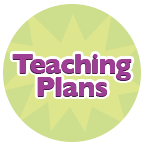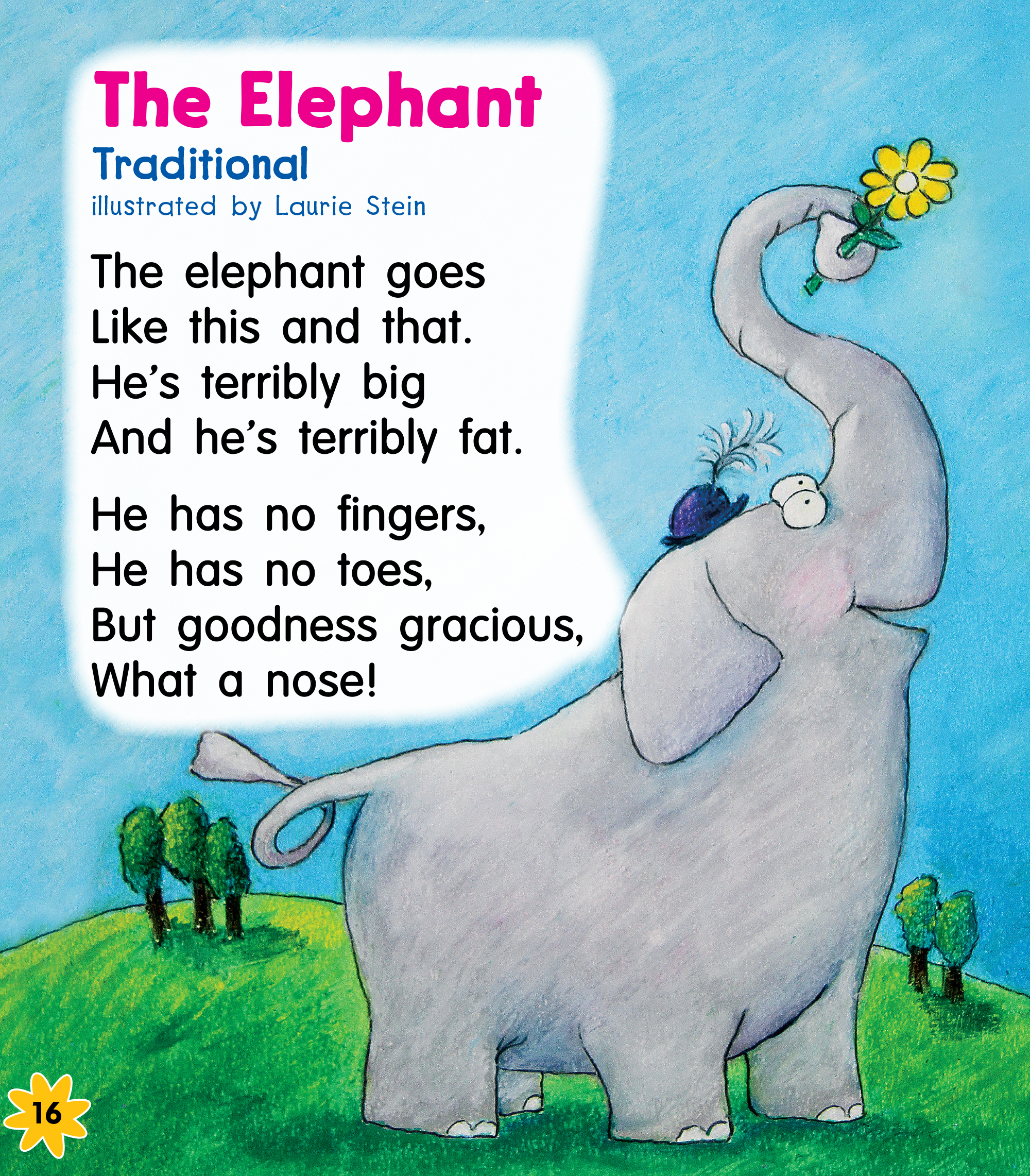Illustrated by Laurie Stein
Text Type: Fiction: Poetry—descriptive poem
Oral Language Teaching Strategy: Help Students to Disagree Agreeably Help students cope with disagreements in social settings by showing them how they can disagree in discussions.
Time: 20 minutes
Materials:
– All Together Now, page 16
– a long, grey sock
– Media Key or Online: “The Elephant” audio
Grouping: whole class and partners
Assessment: Kindergarten Oral Language Assessment Scale See especially the sections on Language for Social Relationships and Phonological and Phonemic Awareness.
FIRST READING
BEFORE READING
-
Let’s play a guessing game of ‘Who Am I?’ to see if you can guess what the animal in today’s poem will be. Listen carefully to my clues. As soon as you think you know what the animal is, raise your hand. After I finish giving my clues, I will ask you to guess the animal.
Tell students that they are going to learn a poem today about an animal.
- Lead students in a guessing game of ‘Who Am I?’ to find out what animal the poem will be about. Clues can include:
- I am a big animal.
- I have big feet but I walk quietly.
- I have floppy ears and sometimes they help keep me cool.
- I have wrinkled skin.
- I have a short neck but a very long nose.
- (Put the sock over your hand & arm and move your arm up and down like a trunk as you give the last clue.) Who am I?
- Ask students to identify which clue helped them the most in identifying what the animal is.
Activating and Building Background Knowledge
- Discuss with students what elephants can do with their trunks, moving the sock trunk up, down, and side to side, saying that it moves ‘like this and that.’
-
When someone says something that I don’t agree with, I tell them that their idea sounds interesting and might be true. Then I calmly tell them what I think. I don’t raise my voice or say things that aren’t nice when I don’t agree with someone.
Show the illustration on page 16 and ask the students to share what they already know about elephants. Have students discuss with an elbow partner and then share their ideas with the class. Model for students how to disagree agreeably in their discussions, if they don’t agree about a fact about elephants. Listen for socially appropriate language and provide alternatives where necessary. [Making connections]
- Listen to students’ sharing and help clarify anything that isn’t right by asking questions to clarify meaning and stimulate more conversation (e.g., “Why do you think my legs are short?” “Why do you think my trunk is long?”).
Setting a Purpose
-
Listen while I read a fun poem called “The Elephant.” I will read it a second time so you can read along with me. When we are finished, I will ask you what the poem says about the elephant—how it describes the animal.
Explain to the students that they should listen carefully to the poem to find out how the elephant is described. Encourage students to join in on a second reading of the poem. [Analyzing]
DURING READING
- Read the poem while swaying back and forth like an elephant might, so that the students can appreciate the rhythmic feel to the poem.
- Focus on comprehension by offering prompts:
- How do you know how big the elephant is? [Analyzing]
- Do you think elephants need fingers and toes? Why not? [Inferring]
- Why do you think the poem says this about the elephant: ‘What a nose!’? [Inferring]
- Do you think the poem gives a good description of how the elephant moves? [Evaluating]
- What parts of the elephant are missing from the description? [Analyzing]
- Encourage students to chime in at the rhyming words at the end of each stanza, as you read the poem. [Phonological awareness]
- Read the poem, tracking the print in the big book. Ask students to clap once for each word as you read it. [Phonological awareness]
Adding Playful Movements
- Reread the poem and teach students the actions:
- The elephant goes
Like this and that.
(sway left and then right) - He’s terribly big
(arms wide open) - And he’s terribly fat.
(hands clasped together and held out in front of them) - He has no fingers,
(make fists with the fingers hidden) - He has no toes,
(place hands over toes) - But goodness gracious
What a nose!
(clasp hands and stretch out arms from head)
- The elephant goes
AFTER READING
- Revisit the purpose for reading by asking students how the poem describes the elephant. Encourage students to use words and phrases from the poem in their responses.
- Reread the poem with actions. You may wish to ask one or two students to lead the group in the actions.
SECOND AND FURTHER READING
The students will want to reread “The Elephant.” During further lessons, consider including a balance of ideas from the following areas:
Engaging in Playful Language Activities
- Reread the poem, tracking the print for the students. Have half of the group of students clap when you read the word at the end of each line. Have the other half of the group stomp their feet when you read the word at the end of each line.
- Reread the poem, having students pretend that their arms are trunks. Have the students pick up a pencil and show how their trunk can move up, down, and side to side, still holding on to the pencil. Have students suggest other things that an elephant could pick up or hold in its trunk.
- Lead a game of ‘Who Am I?,’ giving descriptive clues about an animal other than an elephant, and having students guess the name of the animal.
Extending Comprehension
- Use a boy or girl puppet to ask the students how they would change the poem to describe a kid (e.g., The little girl goes/Like this and that./She’s terribly smart/And she’s terribly fast…). Brainstorm different words to replace those in the poem, writing them on sticky notes and placing them on the big book page. Alternatively, write out a new version of the poem.
- Discuss with students what other details could be added to the poem to help readers understand what an elephant looks like, what it eats, and what it does. You may wish to work together to write a third stanza of the poem to include the details. During the discussion, remind students of ways to disagree agreeably.
- Display the digital cloze version of the text on the Media Key. Working with the whole class, or with a small group, reread together and encourage students to supply the missing words (spaces for words highlighted in yellow). You may decide to pause to consider word predictions and prompt, “Does that make sense?” or “Does that sound right?” Then click on the colour-highlighted spot to reveal the word, saying, “Let’s check that out.” An option on the tool bar allows you to create your own cloze versions of the text to meet the needs of the students you are working with. Click the ‘Help’ button to find out how to use the different features of digital texts.
Developing Phonological Awareness
- Have students sit in a circle and clap on their legs along with each word in the poem as you read. Alternatively, students may clap for each syllable.
- Pick the words ‘big’ and ‘fat’ and have the class come up with rhyming words (e.g., ‘big,’ ‘dig,’ ‘pig,’ ‘wig,’ or ‘fat,’ ‘cat,’ ‘hat,’ ‘mat,’ ‘pat,’ ‘rat’).
- Together with students, orally break the following words into onset and rime: ‘f-at,’ ‘c-at,’ ‘b-ig,’ ‘p-ig.’
Enriching Print Concepts
- Track the print as you read the poem with the students, having them do the actions for the appropriate words (‘this,’ ‘that,’ ‘big,’ ‘fat,’ ‘fingers,’ ‘toes,’ ‘nose’). As you read, keep the pointer on each “action word” until all students have had a chance to do the action.
- After a few readings, ask individual students to take turns in tracking the print.
- Using the pointer, have students circle selected words in the poem (e.g., ‘big,’ ‘fat’) after having students predict what letter they would expect to see at the beginning of each word.
- To build on letter knowledge, locate a lowercase letter (e.g., ‘a,’ ‘b,’ ‘t’) in the text, then ask students to find the corresponding capital letter.
- Ask students to do a word hunt in the poem, looking for words and phrases that appear more than once in the text (‘he’s,’ ‘terribly,’ ‘he,’ ‘has,’ ‘no’).
FOLLOW-UP IN CENTRES
- Provide the big book and a drum or tambourine at a centre. Invite students to keep the beat as they reread the poem or listen to the fluent reading.
- Place other books that include images of elephants in the library corner. Encourage students to share their findings and interesting images with other students.
- Place long socks (preferably grey) at a centre for students to act as elephants in dramatic play. Ask pairs of students to each wear a sock as an elephant trunk and talk to each other about their trunks (e.g., what they are picking up or holding in their trunks, what food they can get with their trunks, how their trunks can help them drink water).
- Ask students to draw or paint pictures of elephants or another animal of their choice. Then ask students to describe the animal they drew (e.g., their colour, their size, their distinguishing features). Scribe student responses or have students write their own simple labels for their drawing.

